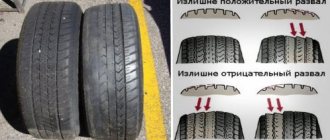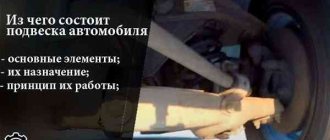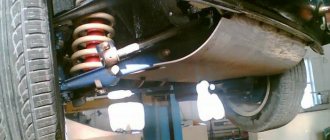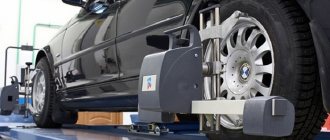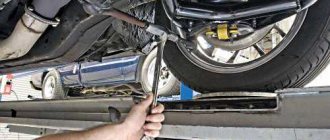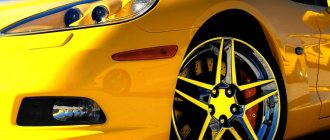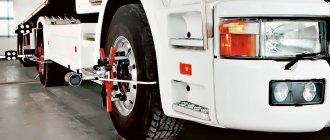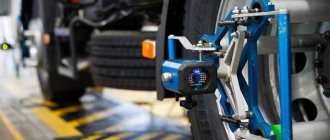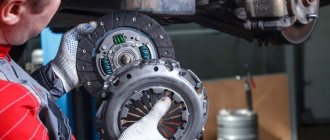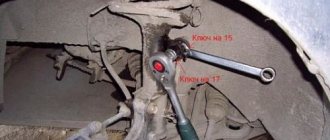Impaired wheel alignment worsens the vehicle's handling and directional stability, increases fuel consumption and tire wear. The need for adjustment is not always associated with seasonal tire replacement, so let's look at in what cases it is necessary to do a wheel alignment after repairing the suspension and replacing the car's steering elements.
What does wheel alignment affect?
Three main characteristics of the wheel alignment angle:
- Camber is the angle of inclination of the wheels in a perpendicular plane relative to the road surface. If the upper part of the wheel is directed outward of the wheel arch, the camber is positive; otherwise, it is negative;
- Toe-in is the angle of installation of the wheels of one axle relative to each other in a plane parallel to the road surface. If the axles laid conventionally through the planes of rotation of the wheels intersect in front of the bow, the toe is considered positive, and if behind the stern, then negative;
- The caster angle is the angle between the axis of rotation of the wheel and the vertical, conventionally laid through the center of the hub. If the turning axis is closer to the rear of the car, the caster is positive, and if it is directed towards the bow, then it is negative.
When driving in a straight line at a constant speed, the car is most stable with zero caster, toe and camber. But when turning in this case, due to the mobility and elasticity of the suspension elements, the wheel will break. Most of the load will be transferred to the part of the tire opposite to the turn in the contact patch with the road surface, which reduces the coefficient of adhesion. Therefore, on modern cars, wheels are installed with a slight negative camber.
On cars with rear drive wheels, during acceleration, a force acts on the front axle, trying to turn the wheels outward relative to the axis of linear motion. Therefore, from the factory, designers calculate a small positive toe angle of the front axle wheels.
On front-wheel drive vehicles, the drive axle angles have a slight negative toe-in, since the tires are subject to a traction force that coincides with the direction of travel.
Caster is necessary for dynamic stabilization of the car and self-centering of the turning axle. The more positive the caster, the more return force is exerted on the wheels, tending to return the steering axle to its original position. Positive caster also affects dynamic camber, providing greater traction between the wheels and the road surface when turning the steering wheel, and increases controllability when coasting and when entering a turn while braking.
Is a wheel alignment necessary after replacing shock absorbers?
Shock absorbers reduce the sway that occurs when the springs operate and hold the car body so that the wheels do not lose traction.
Shock absorbers have no effect on the position of the wheels relative to the vehicle and the road surface. Therefore, there is no need to do a wheel alignment after replacing them.
It's a completely different story with racks. In this case we are talking about a MacPherson type suspension, where the strut is the main part that holds the steering knuckle. In this case, it is necessary to do a wheel alignment.
Adjustment frequency
In what cases is it necessary to adjust the toe-in and camber of wheels?
- After a seasonal tire change. Wheel alignment must be done if tires or wheels of a different size are installed on the car. The offset of the wheel hub, the height and width of the rubber profile affect the distance between the tire contact patch and the wheel turning axis (“rolling shoulder”), which entails a change in wheel alignment angles. If, during seasonal re-shoeing, the tire dimensions and wheels remain the same, in most cases it is enough to “break in” the car on an adjustment stand to check the wheel alignment and caster value. It is worth considering the fact that over the distance traveled after the previous tire change, the wear of individual suspension and steering elements has increased. The need for adjustment in this case is determined not so much by the fact of switching to winter/summer tires, but by possible changes in the geometry of the car’s suspension. Therefore, many recommend doing a wheel alignment 2 times a year, combining the procedure with a seasonal change of tires.
- After disassembling individual suspension elements. Wheel alignment must be re-adjusted after replacing silent blocks, ball joints, shock absorber struts or their supports. Even if the old parts are installed back after dismantling, there is a high probability of their mutual displacement and a change in the rolling arm.
- After repair or replacement of steering parts: steering rods, ends, steering rack, bushings for attaching steering rods to the rack, steering gear.
- In the event of a car pulling to one side, unstable behavior during straight-line movement, acceleration, braking or movement in an arc.
- After a serious accident, which resulted in deformation of the power structure of the body, damage to the subframe, and parts of the car suspension.
Operating a car with such defects results not only in unstable behavior of the car on the road, but also in uneven tire wear.
Let's start with the theoretical basics - when do you need to change tires?
You need to switch from summer to winter tires when the average daily air temperature drops below +10 degrees Celsius. The first frosts begin outside and summer tires begin to “tan,” i.e. becomes less elastic and loses its performance properties, since it is made from a rubber compound not intended for low temperatures. You may not take into account that the road surface takes longer to warm up than the air, and thereby provoke troubles on the road by “changing your shoes” too late.
Accordingly, you need to change back from winter to summer tires when the average daily air temperature rises to +10 degrees Celsius. At positive temperatures, winter tires will become excessively “soft,” increasing the car’s response time to driver actions, including braking, and also wear out faster. But, in general, it’s better to change a set of wheels for the winter earlier and “change your shoes” back later, thus protecting yourself from the “surprises” of the weather in the form of cold snaps and precipitation, which it likes to pamper us with lately.
You don’t have to worry about your tires - if you change them a week or two later, nothing bad will happen, but in this way you can protect yourself from unpleasant situations on the road.
Why do wheel alignment angles change during suspension repairs?
Many car owners are confident that wheel alignment of the front axle is necessary only after replacing the steering rack, tie rods or ends. This opinion is incorrect, since when installing any new suspension part, the position of some elements changes relative to each other. The more parts you change in the chassis during repairs, the greater the chance that the rolling arm will change. This is explained not only by the fact that after dismantling it is impossible to accurately install the parts in the old places, but also by the difference in the parameters of the parts being replaced. Manufacturers are not able to create perfect copies of factory-installed ball joints, steering ends, shock absorber struts, etc.
Therefore, even if, when replacing steering tips, you counted the number of thread turns and installed a new element, as it seems to you, in the old place, the toe angle will change.
Video: When to do a wheel alignment and when not to
Is it necessary to do a wheel alignment after replacing the ball joint?
The ball joint is designed to hold the wheel in a vertical plane. In addition, the ball joint ensures unimpeded rotation of the wheels to change the trajectory of movement.
Many people are interested in whether it is necessary to do a wheel alignment after replacing ball joints? Actually, it depends on the car. In some machines, the balls can be serviced and have a certain wear and tear. If the ball joint wears heavily, the position of the wheels changes. After installing the new support, the wheels take a different angle.
In general, if in doubt, then after replacement you can simply check the wheel alignment and find out for sure.
After removing the steering wheel the car pulls to the side
If you made a mistake when repairing or replacing the steering column, removing the steering wheel, or replacing the steering cable, the car begins to pull to one side, and the steering wheel is crooked when moving in a straight line. There are several reasons for this:
- displacement of the steering rack shaft relative to the splined part of the steering shaft universal joint. When disconnecting the splined part from the shaft, it is necessary to make notes, otherwise during assembly, an error even in one spline will lead to the steering wheel being crooked when moving in a straight line;
- Incorrect installation of the steering angle sensor. Often, the steering angle sensor is supplied in the same housing with the steering column cable (“snail”); it is prohibited to change it separately or disassemble the unit for repair. But since the cable itself is sold as a separate spare part, many car owners resort to replacing it separately. If during disassembly the calibrated position of the steering angle sensor reference disk is shifted, then after installation the actual angle of rotation of the steering wheel will differ from the calculated one. Often, ESD, ABS, ESP and other systems determine the position of the steering wheel precisely from a sensor installed on the steering shaft (less often, a sensor is installed in the steering rack);
- displacement of the steering shaft relative to the steering wheel. On many cars, the steering wheel does not have a fixed centering relative to the shaft, so the steering wheel can be installed offset. As a result, when driving in a straight line, the steering wheel will be crooked. A shift of several degrees can be corrected by adjusting the wheel alignment angles, but this will also require recalibrating the steering position sensor. Therefore, in this case it will be more effective to rearrange the steering wheel.
If your car is equipped with electric power steering, one of the symptoms of incorrect sensor readings is the car pulling to the side. Since the ESD control unit “thinks” that the steering wheel is turned, it tries to help the wheels return to their original position. If such a function is not registered in the EUR software, you can operate the car for some time without even knowing about the malfunction. Driving in this case is unsafe, since the readings from the steering angle sensor are very important for the stability control system, which stabilizes the car in the event of a drift or skid.
On many vehicles, the steering angle sensor can be calibrated using diagnostic equipment. In such cases, an error of several degrees can be corrected without re-disassembling the steering parts and adjusting the wheel alignment.
Incorrect wheel alignment adjustments
Incorrect adjustments of these two parameters are sure to have unpleasant consequences. Let's consider each case separately.
In the case of negative camber, increased wear on the inner part of the tires may be observed, since the bulk of the car's weight will fall on this part. With positive camber, on the contrary, the outer part of the tires. All this means accelerated tire wear, which means early replacement, which is not economically feasible.
When adjusting the camber, a balance must be achieved such that the wheel alignment angles are level when the driver is behind the wheel.
Toe-in leaves an unpleasant imprint on the steering. By changing the position of the wheels relative to the steering wheel, you can change the trajectory of the car without resorting to the help of that same steering wheel. That is, if the car should move in a straight line, when you release your hands from the steering wheel, then it will move away from the given trajectory.
However, it doesn’t matter how the toe-in is set, whether it’s negative or positive, if it’s set incorrectly, then the car’s steering response will be very poor.
A common sign of misalignment is tire squealing when cornering, even at low speeds.
Advantages of 3D adjustment stands
The vast majority of service stations use 3D adjustment stands to adjust wheel alignment angles. Equipment of this type is characterized by high accuracy and allows real-time display of changes in toe-in, camber and caster. Also, most stands have a built-in database with information about wheel alignment angles regulated by the manufacturer. All these factors make wheel alignment adjustment at home impractical, although possible. On the Internet you can find a lot of instructions on how to do a wheel alignment after replacing tires or repairing the chassis. Before starting the adjustment, an experienced technician must inspect the suspension for defective silent blocks, shock absorbers, tie rods, ends, and check the steering rack for play. In the event of a serious malfunction, the wheel alignment cannot be adjusted, since a faulty vehicle suspension behaves unpredictably. Because of this, even after correctly setting the angles on the stand, the car may pull left/right.
Is a wheel alignment necessary after replacing the levers?
Now we come to the last element of the car’s suspension, and this is the lever. The lever is the main part of the suspension along with the struts and the steering knuckle. The lever sets the camber of car wheels.
The way the lever sticks out determines which direction the bottom of the wheels will bend. After replacing the levers, adjusting the wheel alignment is mandatory, but only in cars in which this procedure is provided. For example, Renault cars do not have wheel camber adjustment in the suspension settings. They only have toe adjustable. However, they never change the ball joint separately from the lever.
In this case, camber adjustment is performed by placing special washers between the lever and the car subframe. They are of different thicknesses and affect the protrusion of the lever from the body.
In general, if you don’t know your car that well, then instead of adjusting, you can perform a wheel alignment check, which is not very expensive. In any case, you can't go wrong. And based on the results obtained, you can decide whether to do the alignment yourself or entrust it to a professional.
Why are tires important?
The most important parts in your car are those four small contact patches that interact with the road. These few square centimeters of rubber (approximately the contact patch is comparable in area to the palm of an adult) determine almost everything. Tires transmit the engine's power, allow the brakes to do their job, and determine how well a car will handle corners, whether it's pulling into a parking lot at low speeds or tearing down the highway at solid 60 mph speeds.
This puts a huge load on the tires. This black soft round part is a technological set of rubber of a certain compound (a mixture of rubber and other components that make up tires), polymers, cords (cables that impart rigidity), which are all fused together into a highly engineered profile of an almost ideal shape, a certain weight and with many calculated, specified properties.
This “donut” is then placed on a wheel and pumped with air (sometimes another inert gas, such as nitrogen) to give it shape and rigidity. And only at the tire pressure recommended for your car does normal, safe and trouble-free tire operation begin. The manufacturers behind your vehicle's tires and wheels have worked together to achieve the optimal combination of grip, road feel, ride quality, minimal noise and tire wear.
Alas, only a small number of car owners think about such complex insinuations when hoping to purchase new tires. A modern motorist (especially if he is young) in the USA, the most motorized country in the world, and in Russia, thinks not about quality, but about the large diameters and width of the tire. These wheels look cooler and can change the look of a regular car in the blink of an eye. But bigger is not always better; tuners don’t think about this.
For example, Porsche crossovers have been offering 22-inch wheels in the factory version for quite some time now, in top versions. Is the global sports car manufacturer following the trend?
More likely no than yes. In this case, the use of large wheel rims is justified by the need to install huge brake discs and impressive calipers, but nothing more - a car with large wheels will accelerate, handle and brake at least as well as a similar car with more compact ones, if in some respects it does not worse - for example, in handling. Otherwise, in racing series like the DTM and other touring cars, the cars would have huge rims with very wide tires if it was technically justifiable. However, in reality, the size of alloy wheels is such that it can accommodate reinforced braking systems. Usually it is 18-19 inches.
photo: vestaxray.ru
Alloy wheels on Lada WTCC 18 inches with Yokohama tires
At the same time, regarding tires, we can draw the following conclusion: the area of the supporting surface of the tire does not increase much as its width increases, so you should not chase wide tires; this will not make the car significantly more stable and accelerate better. When a manufacturer makes sports versions, he approaches the changes comprehensively, that is, by installing wider tires, while making changes to the suspension, body kit (to increase downforce), changing the wheel alignment parameters, and so on until installing amplifiers in the body to increase the rigidity of the latter.
All other attempts to improve taxiing only by installing new wheels will not lead to the desired effect. And to be honest, many car owners install wide tires just for the sake of a visual change - the car’s appearance becomes more pleasant, that’s all the agony of choice.
However, there is another category of motorists. They, on the contrary, know how to count expenses and want to buy a set of tires that best suits their car in terms of technical parameters, but at a low price. This is also a losing proposition. A tire, as we said above, is a complex engineering structure, and cheap analogues are simply unable to compete with expensive originals. In this case, the high price is justified a hundredfold. Your safety depends on it.
Which tires don't hum?
It is almost impossible to purchase a summer tire that will not hum. The main reason for the hum is the rigidity of the material, which is the basis of production. But you can choose the least noisy tires, since this depends not only on the composition, but also on the size of the tread pattern and the height of the wheels.
How to choose the least noisy tires
If you follow certain recommendations, you can choose the least noisy tires:
- When purchasing, it is important to pay attention to the tire noise index.
- It is better to purchase tires only from trusted manufacturers. You can first read reviews on motorist forums. Unknown manufacturers may not comply with rigidity parameters and use low-quality material. There is no guarantee that the rubber has passed the required testing.
Installation of different tires
The traffic rules of the Russian Federation (and most other countries) expressly prohibit the installation of tires with different tread patterns on car wheels. However, many drivers neglect this rule, as a result of which problems arise with the car while driving.
When installing tires with different tread patterns on a car, the grip on the road will be different on different wheels. Accordingly, the car will begin to spontaneously pull while driving in the direction where the road grip is higher.
Please note: If for one reason or another you have to use tires with different tread patterns, try to use the same tires on the same axle, this will reduce the likelihood of problems.
How to get rid of the hum of the front wheels when turning
This phenomenon is most often observed in vehicles with power steering. In this case, the hum can appear at different speeds: on some cars it can be heard already at 40 km, on others - at 70. The noise may appear when turning the steering wheel, but the vehicle itself will stand still at this moment.
To establish the cause of the noise, it is necessary to diagnose the performance of the components that affect the control system. If they are the problem, then there will be noise both when moving and when stopping. When noise occurs when cornering, it may vary. For example, when turning left, be present, but when turning right, disappear completely.
The importance of timely adjustment of suspension elements and balancing
The correct position of the chassis provides comfort to the car owner during trips. An unbalanced and incorrectly positioned suspension leads to unwanted vibration, which not only causes discomfort to the driver, but also accelerates wear on the wheels and tires. All this together can lead to an accident.
Correct setting of angles and timely balancing will lead to:
- increasing vehicle stability;
- improved handling;
- reducing the likelihood of skidding;
- fuel economy;
- reducing tire wear.
That is why the driver needs to pay more attention to the location of the wheels and monitor their balance after each manipulation associated with them (for example, re-adjusting or installing new tires).
How does the braking system affect?
This problem may be indirectly related to tire replacement. This happens when the brake mechanisms of one of the front wheels jam. In this case, the machine can move both to the left and to the right. A similar problem may not be noticeable when using winter water tires. But on summer tires the fault literally immediately comes to light due to the fact that summer models are somewhat narrower than winter ones. This problem can be resolved by:
- Development of calipers;
- Replacing cylinders.
In this case, it is recommended to change the working cylinders simultaneously on both wheels to ensure greater reliability.
The video will explain why the car pulls to the side when driving:
Published: February 13, 2022
